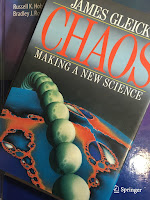 |
| Chaos: Making a New Science, by James Gleick. |
We considered the logistic differential equation as a model for population growth. The differential equation assumes that the population changes continuously. For some species each generation is distinct, and a difference equation is a better model of the population than a differential equation. An example might be an insect population where one generation lays eggs and dies, and the next year a new generation emerges. A model that has been used for this case is the logistic difference equation or logistic mapSo I thought that you could have 1, 2, 4, 8, 16, etc., values of xj, or you could have chaos. I didn’t realize there were other choices. Then I read Gleick’s analysis of James Yorke’s paper “Period Three Implies Chaos.”
yj+1 = a yj (1 – yj/y∞)
with a > 0 and j the generation number. It can again be cast in dimensionless form by defining xj = yj/y∞:
xj+1 = a xj (1 – xj) .
…[Fig. 10.24 in IPMB] shows the remarkable behavior that results when a is increased to 3.1. The values of xj do not come to equilibrium. Rather, they oscillate about the former equilibrium value, taking on first a larger value and then a smaller value. This is a period-2 cycle. The behavior of the map has undergone period doubling…
The period doubling continues with increasing a. For a > 3.449 there is a cycle of period 4… For a > 3.54409 there is a cycle of period 8. The period doubling continues with periods 2N occurring at more and more closely spaced values of a. When a > 3.569946, for many values of a the behavior is aperiodic, and the values of xj never form a repeating sequence. Remarkably, there are ranges of a in this region for which a repeating sequence again occurs, but they are very narrow. The details of this behavior are found in many texts. In the context of ecology they are reviewed in a classic paper by May (1976).
For a < 3.569946, starting from different initial values x0 leads after a number of iterations to the same set of values for the xj. For values of a larger than this, starting from slightly different values of x0 usually leads to very different values of xj, and the differences become greater and greater for larger values of j… This is an example of chaotic behavior, or deterministic chaos.
He proved that in any one-dimensional system, if a regular cycle of period three ever appears, then the same system will also display regular cycles of every other length, as well as completely chaotic cycles. This was the discovery that came as an “electric shock” to physicists like Freeman Dyson. It was so contrary to intuition. You would think it would be trivial to set up a system that would repeat itself in a period-three oscillation without every producing chaos. Yorke showed that it was impossible.This sent me scurrying back to IPMB to see if we saw any hint of period-three behavior in the logistic map. Sure enough, Fig. 10.27 shows a narrow range around a = 3.8 with period three. Not entirely believing my eyes, I wrote a program to do the calculation (it’s an easy program to write) and found a period-three cycle. I made a plot using a format similar to Fig. 10.24 in IPMB.
 |
| A plot of xj vs. j using the logistic map and a = 3.83, showing how the sequence of values converges to three values of x. |
Wow! Period three behavior and chaos; who would have thought they go hand-in-hand.



No comments:
Post a Comment